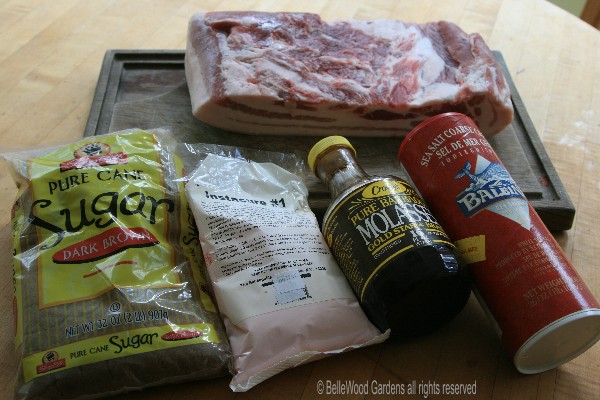
.
If you have any comments, observations, or questions about what you read here, remember you can always Contact Me
All content included on this site such as text, graphics and images is protected by U.S and international copyright law.
The compilation of all content on this site is the exclusive property of the site copyright holder.
Monday, 20 February 2012
Making Bacon
There was great food to sample at last year's Smallholding Festival at Linden Hill Gardens in Ottsville, Pennsylvania. One of the best was some luscious bacon made by Matt Ridgeway of PorcSalt. I could do that, I mused. Of course first I'd need to find fresh pork belly. Then I'd need the pink salt. And if I wanted to smoke it I'd need a barbecue grill. (We used to have a Weber charcoal grill. But I use the infra-red broiler in my Wolf range. So I freecycled it.) But I could do it. Sure I could. And I did.
One of the local supermarkets does have fresh pork belly. Infrequently out in the case but if you ring the bell and chat with the butcher he'll get some for you. PorcSalt cures 12 to 15 pound pieces. With just us two at home I find a two to three pound piece makes more sense. So in typical fashion first I bought the pork.

Pork belly and ingredients for the curing: salt, Instacure # 1, brown sugar and molasses.
Not showing are assorted other embellishments like fresh ginger root and garlic.
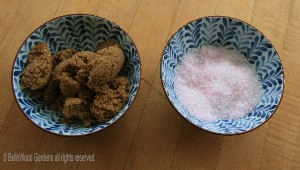
Having bought the pork belly I scrambled to get the pink salt. Also called Instacure #1, it contains salt and 6.25% sodium nitrite. Tinted pink so you won't mistake it for plain salt, just 1/2 teaspoon is needed for safety while curing my 2 to 3 pound piece of belly. Brown sugar on the left, salt mixed with Instacure #1 on the right.

For two to three pounds of pork belly mix together 3 Tablespoons sea salt, 1/2 teaspoon pink salt, & 6 Tablespoons brown sugar. Thoroughly coat the slab of meat, all over, with these dry ingredients. Then let it sit for about 10 minutes at room temperature until the pork belly begins to ooze liquid.
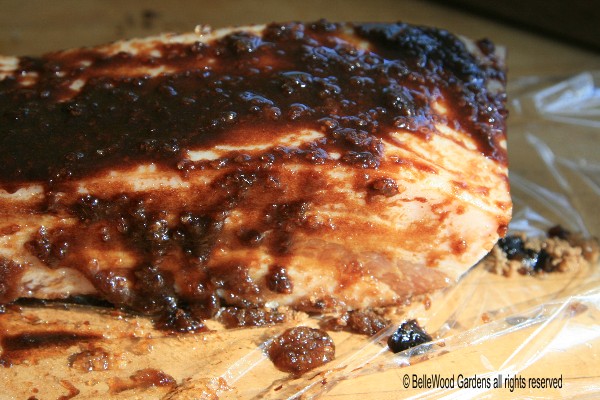
Now coat it with molasses. Wrap tightly with plastic warp and slid into a large sturdy plastic bag.
Refrigerate for seven days. Turn the package over every couple of days, doing it at least twice.
At the end of that time you'd have fresh bacon. Unwrap, rinse under tepid water, pat dry, and enjoy. I wanted to make smoked bacon. So while the pork belly was curing in the refrigerator I - fortunately, given the time of year - was able to find a small tabletop size Weber charcoal grill. And then begged some decent size apple branches from my friend Dick Nagy who has an orchard. Paul used his band saw to chunk up the apple wood for my project.
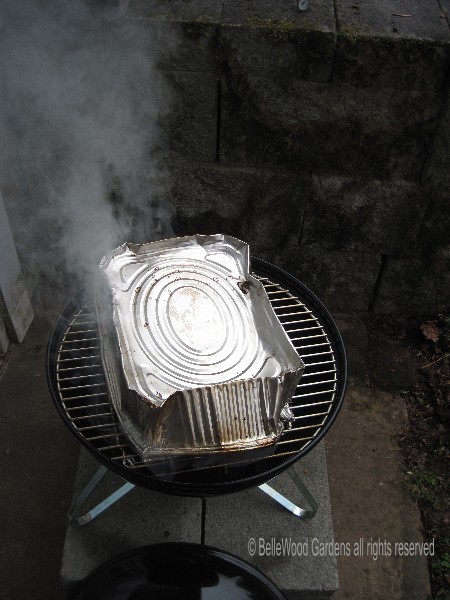
A week later I took the cured pork belly out of the refrigerator, rinsed it off, and patted it dry. Next let it sit at room temperature for about 45 minutes. Fire up the barbecue grill with about 10 pieces of charcoal. No charcoal lighter fluid! Does not improve the flavor. Make the fire in a disposable foil pan. When the briquettes are burning well - white and ashy - cover them with a layer of well soaked wood chips. Apple is nice. I want to try hickory next. Lay metal grill grate in place, put cured bacon on grill, cover with another foil pan, and put the barbecue grill's lid over the whole shebang.
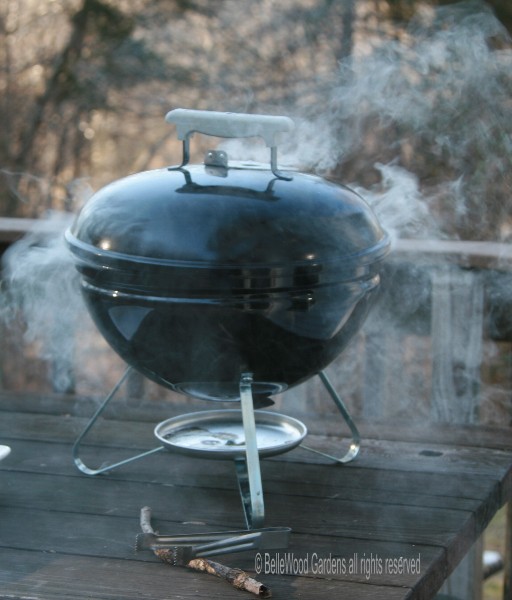
Twiddle with top and bottom vents to damp down the draft, so there's lots of smoke. Remember we're smoking the bacon, not cooking it. The smoking process takes about an hour. Stick around to watch it. You don't want the fire to flare up, or need more soaked wood chips.

Doesn't that look delicious! Hold on, not quite done. The bacon now needs to finish by slow cooking in a 225° Fahrenheit oven for 90 minutes or to an internal temperature of 145° Fahrenheit. Cool, wrap, and refrigerate overnight. Then enjoy.
Paul was dubious about this latest escapade of mine but the first taste convinced him it was all worthwhile. I've made about three batches. The most recent uses maple syrup in place of the molasses. Yummy. And I don't discard the skin I slice off before cooking the bacon. Just as the rind from Parmesan cheese adds flavor when making minestrone or other long cooked dishes smoked bacon rind really adds when I'm cooking dried beans, chicken cacciatore or just about any braise.
Back to Top